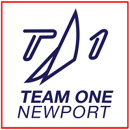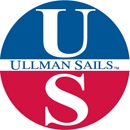

















|
|
|
Scuttlebutt News Center: A Landsailing ProfileDesolation Derbyby Thomas Curwen, Los Angeles Times Curmudgeon's Comment: Free registration is required when clicking on links.
Springtime in the desert, and the wind isn't just blowing. It's howling, ripping down the eastern slopes of the Clark range onto the broad expanse of Ivanpah Dry Lake like a wolf pack tearing up a cloud of dust. But who's complaining? Standing in the middle of the playa, an island of men and women — wearing motocross helmets, bandanas, goggles and surgical masks — huddle in the shelter of a Jeep.
"I bet it's doable between the slammers," someone says. "You'll see them coming," another agrees. "Yeah, but then what will you do?" A burly man with a gray beard steps into the gusts and raises his arm into the air like an ancient prophet. His votaries gather around to peer into the anemometer that he holds aloft: 24 miles per hour with no spikes over 30. In the distance, a row of land yachts lines up behind a rope drawn 100 yards across the playa. Their sleek, three-wheeled hulls look like stealth fighters, and their slivers of sail, the sharp rake of their masts, look fast standing still. The prophet walks in front of them, raises a green flag and suddenly drops it. The sailors crank in the sails and their yachts take off like jets, swiftly disappearing in the vortices of dust that twirl behind them. All you can hear is the wind rushing through their rigging and the whir of wheels on clay. On a downwind leg, one craft peaks at 66.8 mph. Blowing away Five hours from downtown Los Angeles and half an hour from Las Vegas, Ivanpah Dry Lake lies off Interstate 15 near the Nevada line. It is a sun-baked frying pan, surrounded by hard, dry mountains and sloping alluvial fans dotted with creosote bushes. Its surface is cracked and parched like the scaly hide of a monstrous lizard. Hot, dry, dusty and dangerous, land sailing is an acquired taste that fewer and fewer people share. And for no good reason, according to Paul Beckett. Standing on the edge of Ivanpah, this spiky haired, strawberry-blond Kiwi is so besotted by the sheer gonzo-ness of the sport that he's out to convert everyone he meets. His method is simple: radicalize and popularize the sport and, if he's lucky, make a few dollars. Which may make him something of a magician. How do you radicalize a sport in which you're already careening at breakneck speeds, inches off the ground? How do you popularize a sport that takes you to some of the most God-forsaken patches of earth on the planet? And why would you want to? Land sailing has always been a pastime on the fringe, and the 30th annual America's Cup of Land Sailing at Ivanpah last month confirmed it. Of the estimated 300 active land sailors in the country, 83 showed up. The sport's remoteness and constraints challenge even the faithful. While land sailing has been around for some time — Cliff Clavins of the sport point to what appears to be a sail-powered chariot found in an Egyptian tomb — it didn't catch on in the American West until the 1960s. If you were to have driven to El Mirage Dry Lake near Victorville on a spring weekend 30 years ago, you'd have found nearly 100 land yachts screaming up and down the playa, competing for space with the motorcycle racers and bottle-rocket nuts. Then something happened. No one's quite sure what it was. Some blame the rising cost of gasoline (it's not cheap driving to nowhere); others the work-a-day ethic that ties down Americans. Today, on a good weekend, maybe 30 land sailors can be found at El Mirage. A revolutionary "I'm Paul Bickett," Beckett greets you outside his rented Cruise America motor home, his New Zealand accent lengthening his vowels. A windless morning has dawned on Ivanpah. White contrails smudge the sky like a cat's cradle gone slack. It's already 90 degrees and climbing. Lassitude falls upon the makeshift village of motor homes, fifth wheels, campers and tents, except at Beckett's trailer, which is swarming with fans, prospective sales agents and curiosity seekers of his creation — the Blokart. At 5 feet, 5 inches long, this stainless steel and nylon contraption costs $2,200 to $3,500, weighs 60 pounds, springs to life in five minutes, fits in the trunk of your car and has been clocked in excess of 50 mph. It could be the fast track to salvation for land sailing. "The problem with land sailing is that it's too complicated, and it's all about rules. This," he points to one, "this is the McD's, the Starbucks of the sport. This is instant gratification." Instant gratification in Beckett's mind is simple: It's all about the pop-button. He reaches down and picks up a Blokart by a wheel. With one swift jerk, he separates it from the chassis and slams it back with the telltale click. If Beckett seems a little gung-ho, forgive him. He is, after all, managing director of Blokart International Ltd., and that's not international for nothing. This latter-day Hobie Alter, the man who transformed sailing with the Hobie Cat, wants to plant his flag on American soil, as if "The Lord of the Rings" wasn't enough. He wants to put a Blokart in your garage. His friends call him the oldest teenager in New Zealand. Beckett, 50, grew up sailing, surfing, land sailing and hang gliding. He built the first Blokart during Christmas 1999 and distributed them overseas one year later. Now there are more than 4,000 worldwide. Two were at Ivanpah last year; today there are 27. Yet Beckett remains frustrated. "Launching a new sport in the States is difficult," he says, despite a full-page story in Maxim (cleavage and all). "Everyone hangs back to see what's going to happen." The speed monster Alan WIRTANEN has no time for Blokarts. Whether he is on the race course or not, his focus this week is beating Nord Embroden, and on the second leg of a race, he's well in the lead. Wirtanen's boat, yellow as a banana, is hitting close to 70 mph on the downwind legs. As it zips by all you hear is a slight whirring. Its dust trail blossoms into a cloud and drifts across the lake. Fast is fast, but the acceleration of these yachts is thrilling. One gust, one change of tack, and they nearly double their speed. "From 50 to 80 mph in one second," Wirtanen says, then pauses, "well, maybe two." It's out of control, he'll tell you, but still controllable. "Attached to the wind" — the phrase seems like an incantation and describes, both literally and figuratively, the mechanics of sailing on land. When a land sailor attaches to the wind, it's an F-16 launch, a magic carpet with afterburners. The wind clocks forward; the Gs thrust back. Dust swirls away from the wheels, eyes tear up and lips chap. Everything starts to purr from the stress of 100-mph wind speeds. The Demon of Speed is a hairy monster that sits on the threshold of destruction and beckons the cavalier, the bold and the brash. Wires may break, masts splinter and bend, tires shred. Crackups and broken ribs are legendary, but how the adrenaline surges. Straddle the line between anarchy and safety and you feel alive. Piloting a land yacht is not an easy proposition, which makes the Blokart seem to some a Mephistophelean bargain that trades technique for thrill. Pop in the Blokart marketing CD and you'll get the picture. Driven by the music of Minustitle, a punk band from Kiwiland, Blokarts blast across parking lots and beaches, spinning doughnuts and 360-degree rolls and crashing into one another. It's a picture that gives traditionalists pause. "Our sport is about the refinement of sailing skills," Embroden says. "For us, the thrill comes from … seeing how the wind changes around you. [It] is a reminder that the world is bigger than we are, as you're constantly considering the wind, the surface conditions and the trim of your yacht. It is a humbling experience." For sailors like Wirtanen and Embroden, the challenge of the sport is simple: to design, build and sail the fastest land yachts. This week, Embroden succeeded, beating Wirtanen. For both of them the Blokart is a trifle. They dismiss its performance, its price, its dorkiness, and yet, in a moment of weakness, they admit it looks fun. They sense it may be a necessary evil, a tonic for what ails the sport. Sharing the dirt At the 9 a.m. skippers meeting, some land sailors want to complain about the way Blokarters race around the course — as if they're playing chicken with one another. It can be dangerous, someone says. "Besides, we're used to everyone keeping their distance," another adds. "So if you're going to come up to us, just let us know." The Blokarters don't quite understand but agree. Their crafts are so nimble they race in close quarters and have turned land sailing almost into a contact sport. It was a trend that initially worried the established community Down Under and has pushed Beckett to think of sailing Blokarts as a sport different from land sailing. "Sailors are bound by constitutions," he says. "We're the renegades looking for a tangle. We're to land sailing what snowboarding is to skiing." So zealous is Beckett to turn the sport on its head that he's mad for the movie "Dogtown and Z-Boys," the story of the Venice Beach skateboarders who tore up that sport nearly 40 years ago. It's the DVD he plays whenever friends come over for dinner, and just as Jay Adams, Stacy Peralta, Tony Alva and crew made their assault in the city, so plans Beckett. The survival of land sailing is to make it an urban sport because everything is becoming more and more urban," he says. "All we need is a lunch hour and something bigger than a tennis court and smaller than an airport." |
||||



